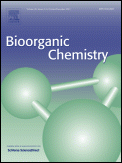
BIOORGANIC CHEMISTRY
Scope & Guideline
Pioneering discoveries at the intersection of science and application.
Introduction
Aims and Scopes
- Drug Discovery and Development:
The journal emphasizes the design and synthesis of novel bioactive compounds, including small molecules and peptides, aimed at therapeutic applications in oncology, infectious diseases, and metabolic disorders. - Chemical Biology:
Research articles investigate the chemical processes within and related to living organisms, contributing to our understanding of biochemical pathways, enzyme mechanisms, and cellular functions. - Natural Products Chemistry:
A significant focus is placed on the isolation, characterization, and synthesis of natural products, exploring their potential as leads for drug development and their biological activities. - Targeted Therapeutics:
The journal publishes studies on the development of targeted therapies, including the design of inhibitors and PROTACs (proteolysis-targeting chimeras), aimed at specific cancer pathways or resistance mechanisms. - Synthesis Methodologies:
Papers often detail innovative synthetic methodologies that facilitate the efficient preparation of complex organic molecules, emphasizing green chemistry and sustainability.
Trending and Emerging
- PROTACs and Targeted Protein Degradation:
The use of PROTACs for targeted protein degradation is gaining momentum as a novel therapeutic strategy, highlighting the importance of protein homeostasis in disease management. - Immunotherapy and Cancer Vaccines:
Research is increasingly focused on immunotherapeutic approaches, including the design of cancer vaccines and immune checkpoint inhibitors, reflecting the growing understanding of the immune system's role in cancer. - Bioconjugation and Drug Delivery Systems:
Innovative strategies in bioconjugation, particularly for drug delivery systems, are emerging, with a focus on improving the selectivity and efficacy of therapeutic agents. - Artificial Intelligence in Drug Discovery:
The integration of artificial intelligence and machine learning in drug discovery processes is becoming a significant trend, facilitating the identification of new compounds and optimization of lead candidates. - Green Chemistry and Sustainable Practices:
There is a notable increase in research focused on green chemistry methodologies, emphasizing environmentally friendly approaches to synthesis and minimizing waste in chemical processes.
Declining or Waning
- Traditional Medicinal Chemistry:
There appears to be a waning interest in classical medicinal chemistry approaches, such as simple structure-activity relationship (SAR) studies, as researchers increasingly focus on integrated approaches that combine structural biology, computational modeling, and advanced synthetic techniques. - Natural Product Isolation Techniques:
The emphasis on traditional methods for isolating natural products has decreased, with a notable shift towards biotechnological and synthetic methodologies that allow for more targeted and efficient compound generation. - Basic Enzyme Kinetics Studies:
Basic enzyme kinetics studies are less frequently reported, as the field moves towards more complex systems involving multi-enzyme pathways and dynamic biological contexts. - Single-target Drug Development:
There is a noticeable trend away from single-target drug development, with a growing interest in multi-target approaches and combination therapies that address the complexity of diseases like cancer.
Similar Journals
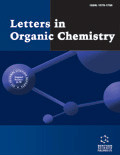
LETTERS IN ORGANIC CHEMISTRY
Bridging Research and Practice in Organic ChemistryLETTERS IN ORGANIC CHEMISTRY is a distinguished journal published by Bentham Science Publishers Ltd, focusing on the rapidly evolving field of organic chemistry. Established in 2005, the journal commits itself to disseminating vital research findings, reviews, and innovative methodologies that contribute to the understanding and advancement of organic chemistry and biochemistry. With an ISSN of 1570-1786 and an E-ISSN of 1875-6255, this journal enhances accessibility and visibility for authors and readers alike, albeit not adopting an open-access model. Positioned within Q4 quartile rankings for both Biochemistry and Organic Chemistry, it serves a niche audience keen on exploring emerging trends and breakthroughs in these disciplines. Its Scopus rankings further reflect its role in the global academic landscape, albeit at the beginning stages of its impact journey. Based in the United Arab Emirates, LETTERS IN ORGANIC CHEMISTRY is dedicated to fostering dialogue among researchers and practitioners, paving the way for future innovations in organic and biochemical sciences.
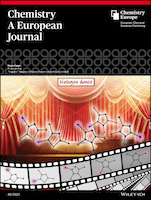
CHEMISTRY-A EUROPEAN JOURNAL
Leading the Charge in European Chemical ScienceCHEMISTRY-A EUROPEAN JOURNAL is a premier academic journal published by WILEY-V C H VERLAG GMBH, specializing in the diverse fields of chemistry and catalysis, with a distinguished focus on organic chemistry. Since its inception in 1995, the journal has established itself as an authoritative resource for researchers and professionals, currently classified in Q1 in Chemistry (miscellaneous) and Organic Chemistry, reflecting its high-quality contributions to the scientific community. With an impressive impact factor and robust Scopus rankings—#33 in Organic Chemistry and #26 in Catalysis—this journal serves as a vital platform for disseminating innovative research findings and critical advancements in chemical sciences. Although not an open-access journal, it provides valuable access options for institutions, ensuring wide reach and engagement within the scientific community. As it converges into 2024, CHEMISTRY-A EUROPEAN JOURNAL remains a key resource for anyone dedicated to advancing the frontiers of chemistry research.
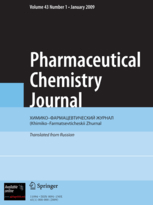
PHARMACEUTICAL CHEMISTRY JOURNAL
Advancing Drug Discovery Through Scholarly Excellence.Pharmaceutical Chemistry Journal is a pivotal publication in the field of pharmaceutical sciences, renowned for its in-depth articles and research findings. Published by Springer in the United States, this journal provides a crucial platform for researchers, students, and professionals dedicated to advancing drug discovery and pharmacology. With an ISSN of 0091-150X and an E-ISSN of 1573-9031, this journal has consistently aimed to promote scholarly communication and innovation within its scope since its inception in 1967. Despite its current Category Quartiles ranking of Q4 in both Drug Discovery and Pharmacology, the journal remains a valuable resource for disseminating new ideas and findings that contribute to the scientific community. Researchers benefit from the journal's commitment to high-quality peer-reviewed content, even in an environment where open access options are currently not available. As the field evolves, the Pharmaceutical Chemistry Journal continues to play an important role in shaping future advancements in drug development and safety.
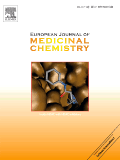
EUROPEAN JOURNAL OF MEDICINAL CHEMISTRY
Innovating Drug Development Through Cutting-Edge Research.European Journal of Medicinal Chemistry, a premier publication by Elsevier France-Editions Scientifiques Médicales Elsevier, has been at the forefront of advancing medicinal chemistry since its inception in 1974. With an impressive impact factor and ranking in the Q1 quartile across multiple categories including Drug Discovery, Medicine (miscellaneous), Organic Chemistry, and Pharmacology, this journal delivers cutting-edge research and reviews that are vital for researchers and professionals in the field. The journal’s scope encompasses the design, synthesis, and evaluation of biological activity of bioactive compounds, making it a critical resource for those looking to innovate in drug development and therapeutic strategies. Although currently not open access, subscribers can benefit from its diverse range of high-quality articles, ensuring the dissemination of knowledge in the ever-evolving landscape of medicinal chemistry. The European Journal of Medicinal Chemistry continues to play a pivotal role in shaping the future of pharmacological research and its application, thus appealing to an audience dedicated to making impactful scientific contributions.

RUSSIAN CHEMICAL REVIEWS
Exploring the Depths of Chemical KnowledgeRUSSIAN CHEMICAL REVIEWS, published by the esteemed ND Zelinsky Institute of Organic Chemistry, RAS, stands as a prominent platform for disseminating high-quality research in the diverse field of chemistry. With an ISSN of 0036-021X and an E-ISSN of 1468-4837, this journal has earned its place in the Q1 quartile of Chemistry (miscellaneous) for 2023, reflecting its outstanding impact and rigorous peer-review process. The journal encompasses a wide array of topics within chemistry, providing critical reviews that advance understanding and foster collaboration among researchers, professionals, and students globally. With its consistent publication since 1970, RUSSIAN CHEMICAL REVIEWS not only serves as a valuable resource for the latest advancements in the field but also plays a crucial role in shaping future research directions. The journal is based in the Russian Federation, with its office located at 47 Leninsky Pr, Moscow 119991, RUSSIA. As an essential reference for those in the chemical sciences, it provides an ideal avenue for authors looking to publish impactful reviews that contribute to the broader scientific community.

BIOORGANIC & MEDICINAL CHEMISTRY
Connecting Molecular Insights to Clinical ApplicationsBIOORGANIC & MEDICINAL CHEMISTRY, published by Pergamon-Elsevier Science Ltd, is a prominent journal in the fields of biochemical research and drug discovery, with an ISSN of 0968-0896 and an E-ISSN of 1464-3391. Established in 1993, it has garnered respect and recognition, evidenced by its categorization in various quartile ranks across 2023, including Q2 in Clinical Biochemistry and Pharmaceutical Science. It holds significant Scopus rankings, placing it in the 75th percentile in Pharmaceutical Science and 74th percentile in Organic Chemistry, highlighting its influential contributions to ongoing research and developments. This journal provides a platform for disseminating advancements in bioorganic and medicinal chemistry, focusing on innovative methodologies, therapeutic advancements, and molecular pharmacology. Although it does not follow an open-access model, it remains a key resource for researchers, professionals, and students aiming to stay at the forefront of scientific discovery in the UK and beyond. The journal’s commitment to enhancing knowledge within the biomedical community makes it an essential read for those passionate about this dynamic field.
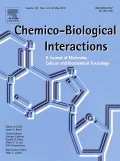
CHEMICO-BIOLOGICAL INTERACTIONS
Bridging Disciplines to Enhance Public SafetyCHEMICO-BIOLOGICAL INTERACTIONS is a premier journal published by Elsevier Ireland Ltd, dedicated to advancing the field of chemical and biological interactions since its inception in 1969. With a robust focus on pharmacology and toxicology, the journal holds a prestigious Q1 ranking in both Medicine (miscellaneous) and Toxicology, reflecting its significance in disseminating influential research. As part of the Scopus database, it ranks #21 out of 133 journals in Toxicology, positioning it in the 84th percentile and ensuring high visibility for cutting-edge studies. This scholarly platform serves as a crucial resource for researchers, professionals, and students who seek reliable and innovative findings at the intersection of chemistry and biology. While currently not open access, CHEMICO-BIOLOGICAL INTERACTIONS provides a comprehensive collection of articles that contribute to the ongoing dialogue in toxin research and its implications on medicinal chemistry, thereby fostering advancements in public health and safety.
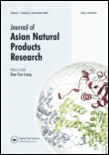
JOURNAL OF ASIAN NATURAL PRODUCTS RESEARCH
Fostering Collaboration for Groundbreaking ResearchJOURNAL OF ASIAN NATURAL PRODUCTS RESEARCH is a prestigious publication in the field of natural products, focusing on valuable research spanning analytical chemistry, pharmacology, and complementary medicine. Published by Taylor & Francis Ltd in the United Kingdom, this journal has established itself as a key resource for academics and professionals seeking to explore advancements in drug discovery and organic chemistry. With a converged publication timeline from 1998 to 2024, the journal boasts several commendable category quartiles as of 2023, reflecting its robust standing in the research community: Q2 in Complementary and Alternative Medicine, Q3 in multiple domains including Analytical Chemistry and Organic Chemistry, and Q4 in Molecular Medicine. Although it currently does not offer open access, the journal remains a valuable compendium for empirical research and innovative studies in areas such as pharmacology and medicinal chemistry. Researchers, professionals, and students alike will find the JOURNAL OF ASIAN NATURAL PRODUCTS RESEARCH to be an essential platform for sharing groundbreaking findings and fostering collaborations that lead to significant advancements in science and health.
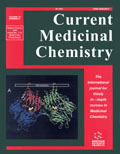
CURRENT MEDICINAL CHEMISTRY
Bridging Chemistry and Health for a Better Tomorrow.Current Medicinal Chemistry is a leading journal published by Bentham Science Publishers Ltd, known for its rigorous focus on the multifaceted realm of medicinal chemistry. With an ISSN of 0929-8673 and E-ISSN 1875-533X, the journal plays a crucial role in disseminating high-quality research findings that bridge the gap between chemistry and health sciences. Operating from Sharjah, United Arab Emirates, it has been a prominent scholarly resource since its inception in 1994, and is expected to continue until 2024. Current Medicinal Chemistry has earned its place in the academic community with an impressive impact factor and categorization in Q1 and Q2 quartiles across various disciplines, including Organic Chemistry, Biochemistry, Drug Discovery, and Pharmacology, highlighting its substantial contribution to these fields. Notably, it ranks 24th in Organic Chemistry and is within the 88th percentile, underscoring its appeal to researchers, professionals, and students alike who are keen on exploring cutting-edge advancements in drug design and development. Although it is not an open-access journal, it provides vital content that informs and inspires innovation in medicinal chemistry, appealing to a global audience committed to enhancing human health through scientific discovery.

Heterocyclic Letters
Unveiling Innovations in Heterocyclic ResearchHeterocyclic Letters is an esteemed journal in the field of synthetic organic chemistry, published by RAMAN PUBL. With ISSN 2231-3087 and E-ISSN 2230-9632, this journal aims to disseminate original research and innovative findings related to heterocyclic compounds, which play a crucial role in medicinal chemistry, material science, and agricultural chemistry. Heterocyclic Letters provides a platform for researchers, professionals, and students to share their insights and advancements, thus fostering academic collaboration and knowledge transfer. The journal is dedicated to maintaining high-quality standards in research publication, making it an essential resource for anyone focused on the latest developments in heterocyclic chemistry. Although it does not currently offer Open Access options, the journal’s rigorous peer-review process ensures that only the most credible and impactful studies are published, contributing significantly to the advancement of the field.